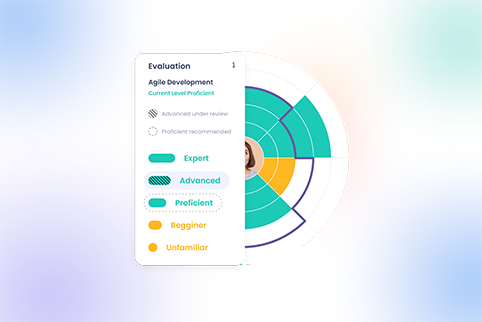
In the fast-paced world of modern work, keeping track of skills isn’t just a good idea—it’s absolutely essential. Why? Because the job market is like a chameleon, constantly morphing under the influence of technological leaps, globalization expanding and consumer preferences shifting. This means the skills that were hot yesterday might not sizzle tomorrow. That’s why it’s important for organizations to recognize the type of skills they should prioritize as a fundamental aspect of their operations.
You don’t have to take our word for it; the data paints a vivid picture. According to the LinkedIn Future of Work Report 2023, skill sets for jobs have already changed by 25% since 2015 and are projected to shift by 65% by 2030 globally. Furthermore, by 2030, an estimated 65% of the skills an employee needs to do their job will change. These statistics aren’t just numbers; they underscore the pressing need for organizations to adapt and stay ahead of the curve.
But it’s not just about keeping up—it’s about thriving in the face of change. According to the LinkedIn Workplace Learning Report 2023, 89% of Learning and Development (L&D) professionals believe that proactively building employee skills for today and tomorrow is crucial for navigating the evolving future of work. In other words, investing in skill development isn’t just a nice-to-have—it’s a must-do for succeeding in the long run, especially in terms of fostering the right type of skills.
The World Economic Forum 2023 Future of Jobs Report adds another layer to the story, predicting that 44% of workers’ core skills will change in the next five years. That’s nearly half of the essential skills employees rely on today. It’s a stark reminder that the skills that got us here won’t necessarily take us where we need to go next.
These figures present a strong case for why skill development and adaptability should be placed as a top priority in companies. When employees’ skills become outdated or mismatched with evolving job requirements, it can lead to bottlenecks, miscommunications, and missed opportunities. Inefficiencies within organizations are also linked to skill stagnation. McKinsey & Company highlights that 40% of respondents cite unclear roles and responsibilities as a cause of inefficiency, further emphasizing the importance of staying abreast of evolving skill requirements.
Furthermore, businesses are keenly aware of the impact that skills gaps can have on their transformative efforts. The World Economic Forum’s Putting Skills First: Insight Report from January 2024 reveals that 60% of businesses acknowledge that skills gaps in the labor market act as stumbling blocks to their business evolution.
Given these insights, it becomes abundantly clear that skill tracking it’s a non-negotiable imperative. Failing to do so risks relegating oneself to the sidelines in a swiftly shifting terrain where adaptability and agility are the name of the game.
But what type of skills should organizations be keeping an eye on? From soft skills that enhance interpersonal effectiveness to job-related technical competencies that drive task execution, each type of skills plays a vital role in shaping career paths and fueling organizational success. So, let’s dive in and explore below these essential skill categories.
Type of Skills You Should Be Tracking
In this section, we’ll explore the type of skills that organizations should prioritize for their workforce’s growth and adaptability. From fundamental soft skills like leadership and communication to emerging skills like Machine Learning and AI Literacy, each skill is vital for cultivating a versatile and resilient team. Let’s jump right into these categories to understand better their critical importance in today’s organizational landscape.
1. Soft Skills
Soft skills, often referred to as interpersonal or people skills, are the intangible qualities that facilitate effective interactions, communication, and collaboration in the workplace. Unlike technical skills, which are specific to particular tasks or industries, soft skills are transferable across job roles, departments, and even industries. They cover a wide variety of abilities, including:
- Communication: The ability to convey information clearly and effectively, both verbally and in writing. Effective communication is essential for building relationships, resolving conflicts, and aligning teams toward common goals.
- Leadership: The capacity to inspire and motivate others, provide guidance, and facilitate teamwork. Strong leadership skills are vital for driving organizational change, fostering innovation, and navigating complex challenges.
- Problem-solving: The aptitude for identifying issues, evaluating options, and implementing solutions. Problem-solving skills are critical for overcoming obstacles, driving process improvements, and achieving strategic objectives.
- Emotional intelligence: The ability to recognize and manage one’s own emotions, as well as understand and empathize with others. Emotional intelligence underpins effective interpersonal relationships, fosters collaboration and trust, and enhances overall well-being in the workplace.
Soft skills are not only invaluable for individual career progression but also for organizational success. Unlike technical skills, they are transferable across job roles, departments, and even industries, making them essential for internal mobility and adaptability. Moreover, in an AI-driven world where routine tasks can be automated, soft skills bring unique value, enabling individuals to excel in roles that require creativity, emotional intelligence, and human connection. Here are several reasons why it’s important to track them:
- Transferability: As mentioned, soft skills are transferable across various job roles, departments, and industries. This adaptability makes them indispensable for facilitating internal mobility and fostering a dynamic, agile workforce.
- Leadership: Soft skills are particularly vital for leadership roles. Effective leaders rely on strong communication, emotional intelligence, and interpersonal abilities to inspire and guide their teams toward achieving shared objectives.
- AI-driven World: In the era of automation and artificial intelligence, this type of skills skills take on heightened importance. While AI excels at executing routine tasks, it cannot replicate the nuanced human interactions and emotional intelligence that underlie effective communication, collaboration, and leadership. Soft skills, therefore, remain indispensable for creating value beyond tasks that can be automated.
2. Job-Related or Technical Skills
Job-related skills, also known as technical skills, are specific abilities and knowledge required to perform tasks related to a particular job or profession. Unlike soft skills, which are transferable across various roles and industries, this type of skills are specialized and tailored to specific functions within an organization. Here are some examples of technical skills:
- Programming Languages: Proficiency in languages like Python, Java, or SQL is indispensable for software developers, data analysts, and IT professionals, enabling them to create, manage, and analyze complex systems and databases.
- Engineering Expertise: Engineers rely on technical proficiency in disciplines such as mechanical, electrical, or civil engineering to conceptualize, design, and optimize intricate systems, structures, and infrastructures.
- Financial Analysis: Financial analysts need skills in financial modeling, data analysis, and risk assessment to evaluate investment opportunities, forecast financial performance, and support strategic decision-making.
- Graphic Design: Graphic designers utilize software tools such as Adobe Photoshop, Illustrator, and InDesign to create visual content, including logos, websites, and marketing materials.
Technical skills enable individuals to perform tasks accurately and efficiently, boosting productivity and ensuring high-quality results. Proficiency in technical skills also drives innovation, facilitates adaptation to changing market demands, and opens doors for career advancement. But let’s get into more detail about why tracking them is essential:
- Task Performance: Technical skills enable individuals to perform specific tasks and responsibilities associated with their job roles. Whether it’s writing code, analyzing financial data, or designing graphics, proficiency in technical skills is necessary to complete tasks accurately and efficiently.
- Productivity and Efficiency: Technical skills contribute to productivity and efficiency in the workplace by streamlining processes, reducing errors, and optimizing resource utilization. Employees with strong technical skills can accomplish more in less time, leading to improved performance and outcomes.
- Quality and Precision: Technical expertise ensures the quality and precision of work outputs. Whether it’s building software or designing structures, proficiency in technical skills is essential for delivering high-quality results that meet industry standards and regulatory requirements.
3. Additional Skills from Past Experience
In addition to core competencies, employees often acquire additional skills through past experiences, which can be categorized as either soft or technical skills. These acquired skills, also referred to as complementary or adjacent skills, play a significant role in shaping an individual’s professional profile.
Soft complementary skills may include traits like adaptability, conflict resolution, or creativity, while technical ones could range from proficiency in specific software to industry-specific knowledge gained from previous roles. It’s imperative to track these skills separately from core competencies because they offer unique opportunities for leveraging diverse experiences within the organization. By recognizing and documenting these additional skills, organizations can better facilitate several initiatives:
- Internal Mobility: Acquired skills may open doors to internal mobility within an organization. Employees with diverse skill sets can transition between departments, roles, or projects, leveraging their unique abilities to add value and contribute to different areas of the business.
- Skill Utilization: Tracking this type of skills enables organizations to leverage employees’ full potential. By recognizing and utilizing employees’ additional skills, organizations can optimize talent deployment, foster cross-functional collaboration, and enhance overall performance and innovation.
- Resilience: By having employees with a wide range of skills, organizations can better withstand disruptions and uncertainties. When faced with unexpected challenges, teams can pivot and find alternative solutions more readily if they have diverse skill sets at their disposal.
4. Desired Skills
Desired skills represent the areas of expertise and proficiency that employees aspire to develop further in their careers. These skills can encompass both soft and technical competencies, reflecting individuals’ personal and professional interests, goals, and aspirations. Whether they fall under the category of soft or technical skills, tracking this type of skills is essential because they provide valuable insights into employees’ career aspirations and development priorities.
Imagine an employee named Sarah, aspiring to climb the ranks from a junior developer to a project manager. She recognizes the importance of both technical proficiency in programming languages like Python and soft skills such as leadership and communication. Tracking these desired skills is crucial for Sarah’s development journey, as they delineate the path she wishes to tread. They symbolize not just her interests but also her ambitions, steering her towards opportunities for growth and fulfillment within the organization.
Organizations can efficiently facilitate a number of projects by recognizing and keeping track of these desired skills:
- Employee Engagement: By tracking desired skills, organizations demonstrate a commitment to supporting employees’ professional growth and development. Employees feel valued and empowered when their aspirations are acknowledged and aligned with organizational goals.
- Talent Management: Understanding employees’ desired skills enables organizations to tailor training programs, learning opportunities, and career pathways to meet individuals’ needs and preferences. This targeted approach enhances talent retention, satisfaction, and performance.
- Strategic Planning: Tracking this type of skills provides valuable data for strategic workforce planning and succession management. Organizations can identify emerging skill trends, anticipate future talent needs, and proactively develop talent pools of skilled professionals to meet evolving business requirements.
5. Emerging Skills
Emerging skills are those that are gaining prominence and becoming increasingly relevant in response to evolving industry trends, technological advancements, and changing market demands. These skills can encompass both soft and technical abilities, reflecting emerging needs and opportunities within the organization’s sector or the broader marketplace.
If we look at soft skills, emotional intelligence (EI) emerges as a critical competency for navigating the complexities of modern workplaces. As organizations increasingly prioritize collaboration, empathy, and resilience, individuals with high EI possess a distinct advantage.
Consider a scenario where a team faces a significant setback on a project. An individual with high EI can effectively manage their own stress levels, remain composed, and provide support to teammates who may be experiencing frustration or anxiety. By offering empathy and understanding, they help alleviate tensions within the team and maintain morale, ultimately contributing to the team’s resilience and ability to bounce back from challenges.
Equally crucial are emerging technical skills like blockchain development. As blockchain technology gains traction across various sectors, individuals proficient in blockchain development are in high demand. Their expertise enables organizations to explore innovative applications, from secure transactions to supply chain management solutions, driving efficiency and transparency in their operations.
That’s why keeping track of emerging skills is essential for several reasons:
- Industry Relevance: By tracking this type of skills, organizations can ensure that their workforce remains aligned with industry trends and demands. This proactive approach enables businesses to anticipate future skill requirements, identify potential skill gaps, and adapt their talent strategies accordingly.
- Enhanced Recruitment and Retention: A proactive approach to tracking emerging skills enhances an organization’s ability to attract and retain top talent. Job seekers are drawn to companies that offer opportunities for professional growth and development aligned with emerging industry trends. Likewise, existing employees are more likely to stay with an organization that invests in their skill development and career advancement.
- Maximize Return on Investment: Investing in emerging skills early can yield significant returns over time. By developing expertise in high-demand areas before they become mainstream, organizations can gain a competitive advantage and position themselves as leaders in their respective industries.
6. Obsolete Skills
Obsolete skills refer to skills that are becoming outdated or no longer in demand due to technological advancements, changing industry practices, or shifts in market preferences. These skills can encompass both soft and technical competencies, reflecting changes in job requirements and organizational needs. Understanding which skills might become obsolete in the near future is crucial for making informed decisions about reskilling employees, reallocating resources, and ensuring organizational agility and competitiveness.
Understanding which skills might become obsolete is important for several reasons:
- Resource Allocation: Continuously investing in training or development programs for skills that are no longer relevant can waste valuable resources. By identifying obsolete skills, organizations can reallocate resources towards training programs that address current needs and emerging trends.
- Talent Management: Understanding obsolete skills allows organizations to make informed decisions about talent acquisition, development, and retention. By identifying employees with obsolete skills, organizations can provide targeted training and development opportunities to help them transition to roles that align with their strengths and interests.
- Risk Mitigation: Obsolete skills pose a risk to organizational performance and competitiveness. Employees with outdated expertise may struggle to contribute effectively to projects or may inadvertently introduce errors or inefficiencies. By tracking obsolete skills, organizations can proactively address these risks and take steps to mitigate potential negative impacts.
Implementing Effective Skill Tracking Strategies
Tracking skills, including emerging skills and those that may become obsolete, requires a systematic approach to gathering, analyzing, and acting upon relevant data. Here’s how organizations can effectively track skills:
- Skills Inventory: Start by creating a comprehensive inventory of the skills present within the organization. This can include both soft and technical skills across various departments, roles, and levels. Conduct surveys, interviews, or assessments to gather information about employees’ current skills, experiences, and aspirations.
- Data Analysis: Analyze the skills inventory data to identify trends, gaps, and areas of opportunity. Look for emerging skills that are gaining importance in the industry or within the organization, desired skills for which you can provide development opportunities to your employees, as well as skills that may be becoming obsolete due to technological advancements or changing business needs.
- Stay Informed on Industry Trends: Regularly monitor industry publications, reports, and market analyses to stay abreast of emerging trends, technological advancements, and evolving skill requirements within your sector. Pay attention to key drivers of change, such as new regulations, market disruptions, or emerging technologies.
- Assessment and Evaluation: Regularly assess and evaluate employees’ skills to ensure accuracy and relevance. This can be done through self-assessments, manager evaluations, peer feedback, or formal skills assessments. Consider using standardized frameworks or competency models to guide the assessment process.
- Document Skill Development: Document instances of skill development or acquisition, such as completing training programs, obtaining certifications, or gaining hands-on experience on projects. This helps track progress over time and identify areas for further development.
- Utilize Technology: Leverage technology tools and software solutions designed for skill tracking and management. These tools often offer features such as automated skill assessments, skill gap analysis, and reporting dashboards to facilitate the tracking process.
- Integrate with Performance Management: Integrate skill tracking into existing performance management processes, such as performance reviews and goal setting. This ensures that skill development is aligned with individual and organizational objectives, fostering continuous improvement and growth.
- Monitor Competitor Strategies: Keep an eye on competitor strategies and talent practices to understand how other organizations are responding to industry trends and skill challenges. This can provide valuable insights into emerging skill requirements and competitive dynamics within the market.
By adopting a proactive and data-driven approach to skill tracking, organizations can effectively identify emerging skills, adjacent skills, anticipate skill obsolescence, and align talent development efforts with strategic business objectives.
Nestor Skills Profile
In addition to the strategies outlined above, organizations can harness the power of Nestor’s skills profile feature to revolutionize their skill tracking efforts. By incorporating Nestor’s innovative platform into their workflow, companies gain access to a comprehensive suite of tools designed to streamline the process of identifying, assessing, and monitoring key competencies within their workforce. With Nestor’s intuitive interface and customizable features, HR professionals can effortlessly create and manage detailed skills profiles for individual employees, providing invaluable insights into their strengths, areas for improvement, and overall professional development trajectory.
What is a Skills Profile on Nestor?
Nestor’s skills profile serves as an innovative and dynamic instrument meticulously designed to offer a comprehensive glimpse into an employee’s skill set and proficiency levels. It goes beyond a traditional resume or performance review by offering a visually appealing and easy-to-understand representation of an individual’s capabilities. Through its user-friendly interface and robust features, Nestor’s skills profile empowers both employees and employers alike to gain deeper insights into skill development, performance trends, and potential growth opportunities within the organization.
Key Features and Benefits:
- Comprehensive Skill Display: Nestor’s skills profile displays all the skills and proficiency levels of an employee, offering a complete picture of their abilities.
- Recent Evaluation Integration: Each profile includes the most recent evaluation of the employee for each skill, providing real-time feedback and insights.
- Transparency and Visibility: The skills profile promotes transparency by making employees’ skills visible to both managers and workers, fostering a culture of open communication and collaboration.
Applications and Use Cases:
- Identifying Skill Gaps: Nestor’s skills profile allows organizations to pinpoint skill gaps and areas for improvement, facilitating targeted learning and development initiatives.
- Guiding Career Growth: Employees can use their skills profile to chart their career paths and identify opportunities for skill advancement, while managers can leverage it to guide individuals’ growth within the organization.
- Talent Management: Organizations can use skills profiles to identify high-potential employees, match individuals with suitable roles or projects, and facilitate internal mobility.
Nestor’s Commitment to Skills Development:
At Nestor, we’re all about focusing on skills. Our platform is built with this in mind, making our skills profiles a central part of what we do. We believe that empowering individuals with visibility and insights into their skills is key to driving continuous growth and performance improvement.
Our unique approach ensures connecting employees with internal opportunities based on smart matching, empowering individuals to apply their skills effectively and contribute to organizational objectives. Streamline internal hiring with skills-based job profiles, ensuring transparency at all levels, and democratizing job opportunities across the organization. Fill open roles faster with our AI smart-matching, identifying individuals with the right skills and inviting them to apply seamlessly.
By adopting Nestor’s skills profiles, organizations can transform their talent management practices, foster a culture of learning and development, and position themselves for success in today’s rapidly evolving business landscape. With Nestor, skills become more than just a list on a resume—they become a strategic asset that drives individual and organizational success.







